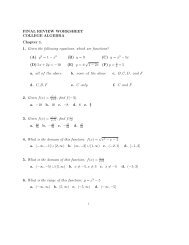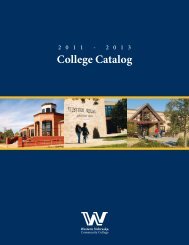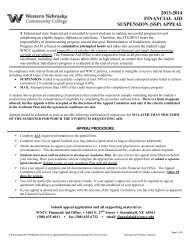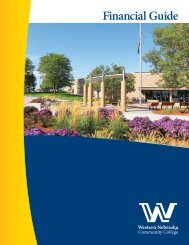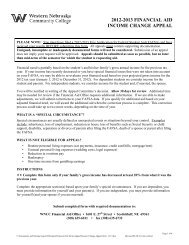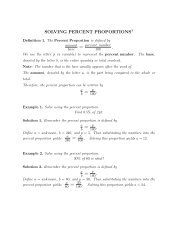WNCC 2010 Self-Study Report - Western Nebraska Community ...
WNCC 2010 Self-Study Report - Western Nebraska Community ...
WNCC 2010 Self-Study Report - Western Nebraska Community ...
You also want an ePaper? Increase the reach of your titles
YUMPU automatically turns print PDFs into web optimized ePapers that Google loves.
The College Council now consists of the President as chair and eight voting and six nonvoting<br />
members. Curriculum Council consists of the Vice President of Educational Services serving as<br />
chair, eight voting and ten non-voting members. Student Services Council consists of the Vice<br />
President of Student Services serving as chair, eleven voting members, and eight non-voting<br />
members. Several standing committees, task forces, and event teams were also identified. A<br />
student representing one of the student leadership councils serves as a voting member at each of<br />
the three Councils, the individual student or student group selection left up to the student<br />
organizations.<br />
Administrative Structure<br />
To understand whether the governance structure promotes effective leadership, an interview was<br />
conducted with <strong>WNCC</strong> President, Dr. Eileen Ely. The following paraphrases of statements made<br />
during the interview represent her views:<br />
• Presidential Position:<br />
Dr. Ely describes her role as the educational head of the College who exercises general<br />
leadership over affairs of the College and brings such matters to the attention of the<br />
WCCA Board that are necessary to keep the members fully informed. The President<br />
carries out the direction given by the Board and has power on behalf of the trustees to<br />
perform necessary administrative functions.<br />
• Interview Summary:<br />
The only limitations to the President’s authority to manage the College are that she may<br />
not violate federal laws, state laws, or <strong>Western</strong> <strong>Nebraska</strong> <strong>Community</strong> College Board<br />
policies. In return, Dr. Ely makes every attempt to keep the Board informed as to<br />
continuous progress in various areas. She also obtains input from the Board, as well as<br />
from members of the President’s Cabinet.<br />
The new administrative structure seems to have improved communications. Dr. Ely indicated that<br />
on occasion Board members have stated that they did not need to know about all actions, some<br />
items being within the scope of the normal College administration functions. According to Dr. Ely, it<br />
appears that with good relations and communications, the Board and administrative have avoided<br />
problems.<br />
In her first year as president, Dr. Ely maintained the existing administrative structure within what<br />
had been called the President’s Executive Team. Based on information gathered in that initial<br />
year, Dr. Ely restructured the organization by adding a new Vice President of Outreach and<br />
switching the Center Director positions at Alliance and Sidney to Associate Dean designations in<br />
the summer of 2007. She also created separate vice-presidential positions for Educational and<br />
Student Services.<br />
In the fall of 2007, Dr. Ely reorganized the Executive Team into the President’s Cabinet. The<br />
President’s Cabinet includes the following members:<br />
Chief Executive Officer<br />
Vice President of Human Resources and Institutional Development<br />
Vice President of Student Services<br />
<strong>Western</strong> <strong>Nebraska</strong> <strong>Community</strong> College Page 55



